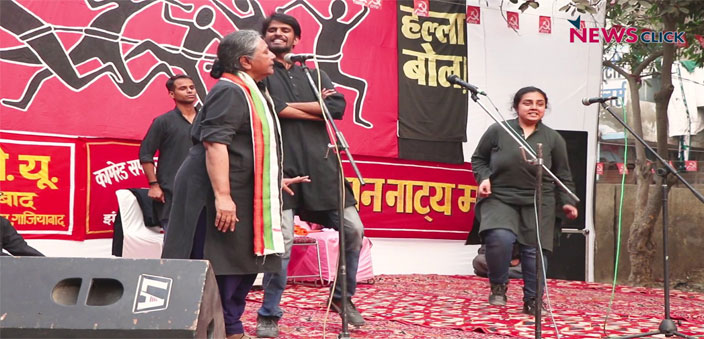Tier after tier of plush red velvet seats. Lofty balconies suspended between the floor and the domed ceiling. Elaborate, gilded, skirtings. An elevated stage framed by thick satin drapes.
Horseshoe-shaped rows of stone steps ascend high towards the open sky. The wind rustles through the trees beyond. Down, below, in the pit, a round space is lit by halogen lamps.
A square room, large. Black walls.A vacant rectangle space along one length of the room. Chairs lined up to point into the rectangle. Spotlights above.
A dusty side street.Passersby milling on the pavement.
A resto-pub at happy hours. Cocktails whirring at the open bar. A susurrus of muted conversations. Clusters of tables facing a 10 feet x 5 feet one-step stage.
Though drastically different from each other in almost all aspects, all the above spaces have one thing in common – they host drama. Theatre space is non-conforming. It is infinite, unrestricted by definition, and unconfined by the diktat-s of shape, size and scale. It is any space that lends itself to a performance. From a mime standing at a busy street corner, to an ensemble cast of a hundred plus on a stage with changing backdrops… and everything in-between, falls within the realm of theatre space. Over centuries it has evolved and synced its form with the demands of the prevailing times. During wars and revolutions, it took to the streets. When peace prevailed, it flourished in playhouses both grand and unadorned. It shrinks to fit into small boxes in cramped urban areas, and spills out into maidan-s in the rural vastness.
While there are many theories, there is no single established view regarding the origin of theatre as a performance. But, it would be safe to say that performance has probably existed since man learnt to coordinate the movement of his limbs. Perhaps, the first performance was in a cave as prehistoric man recreated the events of his day’s hunt for his family’s eyes. Over centuries, speech developed and led to the creation of language, the performances became more detailed and nuanced. The audience size grew and performance spaces emerged.
Through the ages
As far back as 700 BC, the Greeks had realised that all they needed to host a dramatic performance was a place for the artists to stand, and a place for the audience to sit. Benches were built in tiers on slopes of hills, and performers took their place at the base of the hill. These theatres may have been carved out of hillsides, but with a seating capacity of thousands, their scale was not limited. These theatrons hosted plays, musical concerts, political speeches, sporting contests and more. They were not looked upon merely as entertainment; they were an integral part of the citizens’ civic life which made the theatrons living, throbbing centres of the cities.
From mainland Europe, theatre travelled to England. By the medieval times it had taken on the shape of travelling theatre known as ‘Mummers’ Plays’. Actors and performers travelled from one town to another staging folk plays on streets or in yards of inns. But, it was in the late 16th century, under the patronage of Queen Elizabeth I, that dramatic arts started to blossom. This was the period when the first playhouses were built. Three to four-storeyed structures with thatched roofs were built around courtyards. An elevated stage jutted into the centre of the courtyard, the rear of which was used by performers to enter and exit, and the other three sides were surrounded by the audience.
Today, the Shakespeare’s Globe Theatre in London, a replica of the original Globe Theatre, recreates the same atmosphere for visitors. During summer, Shakespearean plays are staged here with audiences seated in the galleries as well as standing around the stage in the “pit”, much like their counterparts from the 17th century.
Over the years, productions grew more elaborate and so did their arenas. Theatre moved indoors and sets, backdrops, lights and sound gained importance. Since the earliest enclosed theatres were open only to royalty and those of higher social stature, the interiors of the playhouses became grander. Theatres became a place to be seen. Men in coattails and women in silk gowns and diamonds sipped wine in the elaborate foyers, before making their way to their plush seats. While plays continued to be performed in town centres and inns for the masses, it was at this time that theatre gained reputation as entertainment for the elite, a reputation that persisted over the years.
Moving with the times
Recent times have seen a change. Theatre is turning a curve and expanding its scope. This has led to the development of new kinds of spaces and mediums or, perhaps it is these spaces which are enabling the influx of new audiences. It is a chicken and egg scenario.
While the term ‘black box theatre’ has come in regular parlance in more recent times, experimentation with the model started way back in the 1920s. But, it was in the 1960s that the concept took root prompted by the finite nature and rising costs of urban space. All that is needed to create a black box theatre is a large room with bare walls, usually painted black. It is flexible in shape, size and audience-stage orientation, and can thus mould to any genre and scale of performance. The lack of a formal stage allows for a more intimate connection between the audience and the performers. The low cost of creating this kind of a space has brought a wider spectrum of creatives into the folds of theatre and thus, led to a revolution of sorts in the field of dramatic arts.
One of the main constraints in expanding the accessibility of theatre is the cost and logistics of transporting. Unlike films, theatre cannot be boxed and shipped. Or, it could not be. In 2009, London’s Royal National Theatre launched its initiative National Theatre Live (NTL) to broadcast its plays via satellite. French tragedy Phedre, authored by Jean Racine and performed by Helen Mirren was the first to be aired live on screens across the UK. In less than a decade NTL has spread its net to include more than 2,000 screening venues across the globe. The purist may arch a cynical eyebrow at this ‘cinemafication’ of theatre, but for theatre lovers it is a treat to have access to the best of West End, just around the corner.
The Indian context
The theatrical arts were established in the Indian subcontinent as early as 1 BC. Sanskrit was the preferred language of theatre and performances were staged on sacred grounds by priests. Over the next few centuries, some great dramatists like Kalidasa, Bhavabhuti among others, took centrestage. At the time, the role of theatre extended beyond entertainment, they were meant to carry a socio-cultural relevance for the audiences. It was only natural then that temples, as cultural centres, became the setting for these performances.
The British brought their theatre culture with them, not just their stories, but also their playhouses. The Gaiety Theatre in Shimla, constructed in the Gothic style at the end of the 19th century, housed VIP boxes which were monopolised by the ‘Who’s Who’ of the region. The renovated theatre continues to use the traditional curtain system of pulleys and sandbags, and hosts the occasional performance during summertime.
In the 1970s, playwright Safdar Hashmi took theatre to the streets. Through his company, JANAM, Hashmi performed his works in the streets, in trade union meetings for factory workers, in the fields for peasants. His writing projected his communist views, and for him “street theatre was a mode to make art available to the people”.
Recent years have seen many developments in the theatre space, especially in urban India. The theatre scene in Mumbai is as varied as the city’s populace. Elegant auditoriums like the Tata Theatre, Rang Sharda and the refurbished Royal Opera House are jostled for space by contemporary and minimalist spaces like Tamaasha Studio, the Cuckoo Club and half a dozen others. Add to that, street theatre during art festivals and college fests, and performances in restaurants and bars, the open-ended definition of theatre space is playing a vital role in elevating the city’s drama culture.
Space and the art of theatre
At Mumbai’s NCPA Experimental Theatre, a black box theatre, a group of clowns take centrestage. It is a play within a play, as a company of clowns decide to stage their version of Shakespeare’s Hamlet. The Bard’s English gives way to gibberish in this production, and the clown skilfully turns the tragedy into a comedy. The audience is at eye level with the actors and privy to every expression that flashes across their faces. Across the seas, in the Queen’s land, Benedict Cumberbatch takes on the role of Hamlet. Staged at the Barbican Theatre, one of the largest playhouses of London’s Westend, this production is replete with true-to-its-times costumes, and larger than life sets and backdrops. The scale of the production complements the grandeur of the arena, anything less would underwhelm.
And then there is the Kronborg Castle in the Danish town of Elsinore, where Shakespeare presumably set Hamlet. During summers, the grand Renaissance style castle becomes the backdrop for Hamlet’s lore. Hamlet woos Ophelia in the sunlit courtyard, moves to the ramparts for the ghost scene, and later to the Grand Hall for a duel. The visitors follow the actors through the castle rooms as the saga unfolds. Seeing the play in the same setting that Shakespeare visualised it in, adds a different layer to his words.
The role of the space in a performance cannot be marginalised. The same story changes form as it travels from one space to another, and feeds off its setting. The performance and the space are not independent of each other, they work hand in glove. For the theatre lover, the evolution of the space is exciting as it adds another dimension to the multi-sensory experience of an evening at the theatre.


 [/column]
[/column]